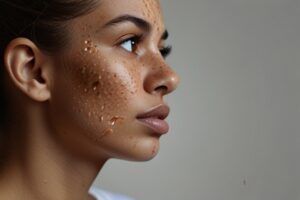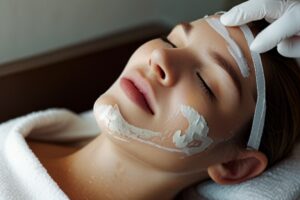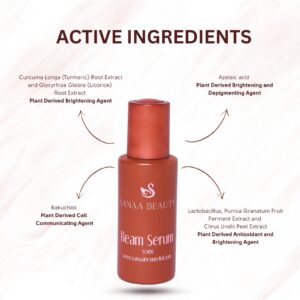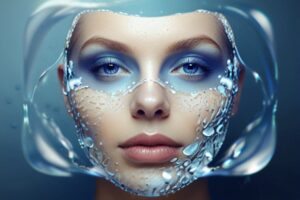Daily Skin Protection Tips: Understanding Hyperpigmentation
What to Expect and Learn from This Guide
By reading this guide, you’ll gain a deeper understanding of hyperpigmentation—its causes, prevention, and treatment options. Whether it’s due to sun exposure, hormonal changes, aging, or inflammation, this guide offers practical advice on how to protect your skin and manage hyperpigmentation effectively.
You will also learn about daily skin protection tips that can help prevent future discoloration, the role of topical treatments like serums, and how procedural treatments can offer more intensive solutions.
Expect clear, actionable steps to incorporate into your skincare routine, enhancing your skin health and preventing further damage.
Table of Contents
Causes of Hyperpigmentation
Hyperpigmentation is a common skin concern that can affect anyone, regardless of skin type or color. It’s characterized by darkened patches or spots on the skin, which can be frustrating and affect your confidence. Understanding hyperpigmentation is crucial for maintaining an even skin tone.
By incorporating effective daily skin protection tips, you can prevent and manage skin discoloration. Let’s delve into some of the most common causes of hyperpigmentation and how you can protect your skin from it.
Sun Exposure - The Main Cause
One of the biggest causes of hyperpigmentation is sun exposure. When you spend time in the sun, your skin produces more melanin to protect itself from UV rays. This is what gives you a tan, but it can also lead to those pesky dark spots. You might notice them more on areas frequently exposed to the sun, like your face, hands, and shoulders.
You can think of melanin as your skin’s natural sunscreen, but even it has its limits. Over time, excessive sun exposure can cause an uneven distribution of melanin, resulting in hyperpigmentation. The best way to prevent this is by wearing broad-spectrum sunscreen every day, even when it’s cloudy. Hats, sunglasses, and protective clothing are also great tools to keep those UV rays at bay.
Hormonal Changes - A Hidden Cause

Hormonal changes are another major cause of hyperpigmentation, particularly in women. You might have heard of melasma, often referred to as the “mask of pregnancy.” This condition causes brown or gray-brown patches on the face and is linked to hormonal changes during pregnancy. However, it can also occur due to birth control pills or hormone replacement therapy.
When your hormones fluctuate, they can stimulate an overproduction of melanin. This doesn’t mean you have to avoid hormonal treatments, but it’s important to be aware of the potential skin changes. If you notice dark spots forming, talk to your dermatologist about safe and effective treatments that can help manage melasma and other hormone-related pigmentation issues.
Inflammation - The Result of Skin Injuries
Hyperpigmentation can also result from inflammation or injury to the skin. This type is known as post-inflammatory hyperpigmentation (PIH). If you’ve ever had acne, eczema, or a skin injury, you might have noticed dark spots lingering after the wound has healed. This is because your skin produces more melanin in response to the injury, leading to discoloration.
PIH can be particularly stubborn and frustrating. The key to preventing it is to avoid picking at your skin and to treat any inflammatory conditions promptly. Gentle skincare routines and products that reduce inflammation can also help. If you already have PIH, ingredients like azelaic acid and bakuchiol can be effective in fading these spots over time.
Aging: Natural Changes Over Time
As you age, your skin undergoes various changes, including an increase in hyperpigmentation. These age spots, or liver spots, are a common occurrence and are primarily caused by years of accumulated sun exposure. Your skin’s ability to repair itself slows down, and the effects of sun damage become more apparent.
You can’t stop the aging process, but you can definitely slow down its effects on your skin. Using anti-aging products, such as those containing retinoids and antioxidants, can help maintain an even skin tone. And as always, diligent sun protection is your best defense against new spots forming.
Medications and Chemicals - Unexpected Triggers
Certain medications and chemicals can also cause hyperpigmentation. Some antibiotics, chemotherapy drugs, and even over-the-counter pain relievers like ibuprofen can lead to increased melanin production. Additionally, exposure to certain chemicals, such as those in hair dyes or perfumes, can cause your skin to react and darken.
If you suspect that a medication or product is causing hyperpigmentation, consult with your healthcare provider. They might be able to suggest alternatives or treatments to mitigate the effects on your skin. Always patch-test new skincare products to ensure they don’t cause adverse reactions.
Genetic Factors - It's in Your DNA
Sometimes, hyperpigmentation can be a matter of genetics. If your parents or grandparents had dark spots or patches, you might be more prone to developing them too. Conditions like melasma and certain types of PIH can run in families, making you more susceptible.
While you can’t change your genetics, being aware of your predisposition can help you take proactive steps. Regular use of sun protection, a consistent skincare routine, and early intervention at the first sign of hyperpigmentation can make a big difference in managing your skin.
Topical vs. Procedural Hyperpigmentation Tips

When it comes to tackling hyperpigmentation, you have two main treatment categories to consider: topical and procedural. Each has its benefits and can be effective, depending on your skin type, the severity of your pigmentation, and your personal preferences. Incorporating daily skin protection tips into your routine can enhance the effectiveness of both approaches.
Let’s break down these options to help you make an informed choice
Topical Treatments - Easy and Effective
Topical treatments are often the first line of defense against hyperpigmentation. These are products you apply directly to your skin, and they work by targeting the pigmentation at its source. Ingredients like vitamin C, retinoids, and hydroquinone are popular choices.
Vitamin C is known for its brightening properties and its ability to inhibit melanin production. It also provides antioxidant protection, which helps reduce further damage. Retinoids, derived from vitamin A, promote cell turnover, which helps fade dark spots over time. Hydroquinone is a potent skin lightener, though it should be used under the guidance of a dermatologist due to potential side effects.
One of the benefits of topical treatments is their ease of use and accessibility. You can incorporate them into your daily skincare routine with minimal fuss. However, they require consistency and patience, as it can take several weeks or even months to see noticeable results.
For those looking for a more holistic approach, products like Sanaa Beauty Beam Serum offer a combination of ingredients specifically formulated to address hyperpigmentation. With components like azelaic acid and licorice root extract, Beam Serum provides targeted treatment to brighten and even out skin tone.
Procedural Treatments - More Intensive Solutions
Procedural treatments are more invasive and usually involve professional intervention. They can be highly effective for stubborn or severe cases of hyperpigmentation that don’t respond to topical treatments. Common procedures include chemical peels, laser therapy, and microneedling.
Chemical peels involve applying a solution to the skin that exfoliates the top layers, removing pigmented cells and encouraging new skin growth. This can be a great option for tackling sun spots and melasma. Depending on the strength of the peel, you might need multiple sessions and some downtime for recovery.
Laser therapy uses focused light to target and break down melanin deposits in the skin. This treatment can be precise and effective, especially for deeper pigmentation issues. However, it’s important to choose a skilled practitioner to minimize risks and achieve the best results.
Microneedling involves using fine needles to create tiny punctures in the skin, stimulating collagen production and improving skin texture. This method can help reduce the appearance of dark spots and improve overall skin tone. It’s generally well-tolerated and requires minimal downtime.
Combining Topical and Procedural Treatments
In many cases, combining topical and procedural treatments can offer the best results. Topical products can prepare your skin for procedural treatments by addressing pigmentation from the surface, while procedures can enhance the efficacy of these products by reaching deeper layers of the skin.
For instance, you might use a topical brightening serum in conjunction with a chemical peel. The serum helps maintain and enhance the results of the peel, while the peel provides a deeper level of exfoliation. This combined approach can lead to more significant improvements in hyperpigmentation.
Always consult with a dermatologist or skincare professional before starting any new treatment regimen. They can assess your skin condition, recommend suitable treatments, and help you develop a personalized plan. This ensures you get the most effective and safe results based on your unique skin needs.
How Beam Serum Addresses Multiple Skin Issues
If you’re looking for a skincare product that does more than just address one concern, Sanaa Beauty Beam Serum might be your new best friend.
This powerful serum is designed to tackle multiple skin issues, offering a comprehensive approach to achieving a radiant complexion. By incorporating Beam Serum into your routine along with daily skin protection tips, you can maximize its benefits and maintain healthy, glowing skin.
Let’s explore how Beam Serum can help with various skin challenges and why it might just become a staple in your skincare routine.

Fading Hyperpigmentation - A Brightening Miracle
Hyperpigmentation is a common skin issue, characterized by dark spots or uneven skin tone. Beam Serum is specially formulated to target these concerns with a blend of powerful ingredients. One key player in this serum is Bakuchiol, a natural alternative to retinol. Bakuchiol helps to reduce melanin production, the root cause of dark spots, effectively brightening your skin.
Regular use of Beam Serum can lead to a more even complexion by lightening hyperpigmented areas. Its gentle yet effective formulation means you can achieve a balanced skin tone without causing irritation. Whether dealing with sun spots, age spots, or post-inflammatory pigmentation, Beam Serum helps to fade and balance your skin tone over time.
Hydration Boost - Quenching Your Skin’s Thirst
While Beam Serum is excellent for targeting hyperpigmentation, it’s important to also focus on hydration. For optimal hydration, consider incorporating Sanaa Beauty’s Morning Dew Serum into your routine. Morning Dew Serum is renowned for its exceptional hydrating properties, providing deep moisture and plumpness to your skin.
Morning Dew Serum contains ingredients like Sodium Hyaluronate, which is a form of Hyaluronic Acid that attracts and retains moisture. Using it in conjunction with Beam Serum ensures your skin remains well-hydrated while addressing pigmentation issues. Together, these serums offer a comprehensive approach to both hydration and skin tone correction.
Reducing Inflammation - Calm and Soothe
Inflammation can exacerbate various skin issues, including redness and hyperpigmentation. Beam Serum contains calming ingredients like Licorice Root Extract and Azelaic Acid, which work together to reduce inflammation and soothe irritated skin. Licorice Root Extract has natural anti-inflammatory properties that help to calm your skin, while Azelaic Acid further aids in reducing redness and promoting an even tone.
If you struggle with sensitive or inflamed skin, Beam Serum’s anti-inflammatory benefits can provide significant relief. By soothing your skin and reducing irritation, this serum helps to create a more balanced and comfortable complexion.
Improving Skin Texture - Smooth and Refined
Achieving a smooth skin texture can be challenging, but Beam Serum is designed to help. Its formulation includes ingredients that promote cell turnover and exfoliation, such as Bakuchiol and Azelaic Acid. These components gently remove dead skin cells, revealing a fresher, more refined surface underneath.
For an even more polished look, you might also consider adding Morning Dew Serum to your regimen. This hydrating serum helps to enhance the overall texture of your skin by keeping it plump and smooth. The combination of Beam Serum’s exfoliating properties with Morning Dew’s hydrating benefits can lead to a smoother, more radiant complexion.
Protecting Against Future Damage - Preventative Care
Preventing future skin issues is just as crucial as addressing existing ones. Beam Serum offers protective benefits with its antioxidant-rich formula, which helps to neutralize free radicals. Free radicals are unstable molecules that can damage skin cells and contribute to premature aging.
By using Beam Serum, you’re not only treating current concerns but also protecting your skin from future damage. This preventative care ensures your skin remains healthy and resilient over time. Pairing Beam Serum with Morning Dew Serum can provide a well-rounded approach to both immediate and long-term skin health.
Preventive Measures - Protecting Your Skin Daily

Taking care of your skin isn’t just about treating issues after they arise; it’s also about preventing problems before they start.
Adopting a daily skincare routine with daily skin protection tips can keep your skin healthy and radiant for years to come. Let’s explore some effective strategies to protect your skin every day.
Sun Protection: Safeguarding Your Skin from Harm
Sun exposure is one of the biggest threats to your skin’s health. UV rays can cause premature aging, dark spots, and increase the risk of skin cancer.
To keep your skin safe, make sunscreen a part of your daily routine, even on cloudy days. Choose a broad-spectrum sunscreen with at least SPF 30 and apply it every morning, even if you’re staying indoors.
Don’t forget to reapply sunscreen every two hours if you’re spending extended time outdoors. This simple step helps protect your skin from harmful UV rays and prevents damage that could lead to pigmentation issues.
Wearing a hat and seeking shade during peak sun hours also adds an extra layer of protection.
Hydration - A Key Daily Skin Protection Tip
Keeping your skin hydrated is crucial for maintaining its health and preventing dryness and irritation. Dehydrated skin can look dull and may be more prone to issues like flakiness and premature aging. Drink plenty of water throughout the day to keep your skin hydrated from the inside out.
In addition to drinking water, use a hydrating moisturizer that suits your skin type. Look for ingredients like Hyaluronic Acid and glycerin, which help retain moisture and keep your skin feeling soft and plump. Applying moisturizer both morning and evening helps maintain your skin’s natural moisture barrier and keeps it looking healthy.
Gentle Cleansing - Essential Daily Skin Protection
Cleansing your skin is an essential step in any skincare routine, but it’s important to do it gently. Harsh cleansers or scrubbing too aggressively can strip your skin of its natural oils, leading to irritation and dryness. Choose a mild, sulfate-free cleanser that matches your skin type and cleanses without causing harm.
Cleanse your face twice daily—once in the morning to remove overnight oils and once before bed to clear away impurities and makeup. Use lukewarm water and your fingertips to apply the cleanser, avoiding any rough scrubbing. This gentle approach helps keep your skin clean while preserving its natural balance.
Remember to avoid irritants and minimize skin stress.
Your skin can react negatively to various irritants, such as harsh chemicals, fragrances, and allergens. To protect your skin, opt for skincare products that are free from artificial fragrances and irritating ingredients. Look for products labeled as hypoallergenic or designed for sensitive skin if you’re prone to reactions.
Pay attention to how your skin responds to new products and avoid those that cause irritation. Also, consider doing a patch test before using a new product all over your face. This helps you identify any potential reactions and prevents unnecessary discomfort.
Healthy Diet - Supporting Your Daily Skin Protection Routine
What you eat can significantly impact your skin’s health. A balanced diet rich in vitamins, minerals, and antioxidants supports skin repair and protection. Incorporate plenty of fruits and vegetables, whole grains, lean proteins, and healthy fats into your meal.
Foods high in antioxidants, such as berries, leafy greens, and nuts, help fight free radicals that can damage your skin. Omega-3 fatty acids found in fish and flaxseeds can help maintain your skin’s moisture barrier. Eating a varied diet provides your skin with the nutrients it needs to stay vibrant and resilient.
Additional Daily Skin Protection Tips - Sleep and Exercise
Exercise isn’t just good for your overall health; it also benefits your skin. Physical activity increases blood flow, which helps deliver nutrients and oxygen to your skin cells. Sweating during exercise also helps to clear out toxins from your pores.
Aim for at least 30 minutes of moderate exercise most days of the week. Whether it’s jogging, yoga, or a brisk walk, find an activity you enjoy. Just remember to cleanse your skin after sweating to remove any sweat and bacteria that might contribute to breakouts.
Additional Daily Skin Protection Tips - Sleep and Exercise
Protecting your skin daily is essential for maintaining its health and radiance. Incorporate these daily skin protection tips into your routine: shield your skin from UV damage with broad-spectrum sunscreen, keep it hydrated with a moisturizer containing Hyaluronic Acid, and cleanse gently with a mild cleanser.
Avoid irritants by choosing hypoallergenic products and nourish your skin from within with a balanced diet rich in antioxidants.
Regular exercise also promotes healthy skin by increasing blood flow and clearing toxins.
Additionally, ensure you’re getting enough sleep, as rest is crucial for skin repair and regeneration. By following these daily skin protection tips, you can maintain a glowing, healthy complexion year-round.
By adopting these daily skin protection tips, you’ll safeguard your skin against damage and keep it looking vibrant and youthful. For a boost in your skincare routine, check out Sanaa Beauty Beam Serum
Don’t stop now! Here’s another post you’ll love
From Breakouts to Beauty: Managing Acne with Skincare
The Secret to Clear Skin: Beam Serum’s Top Ingredients
The Science Fact Skincare vs. Makeup